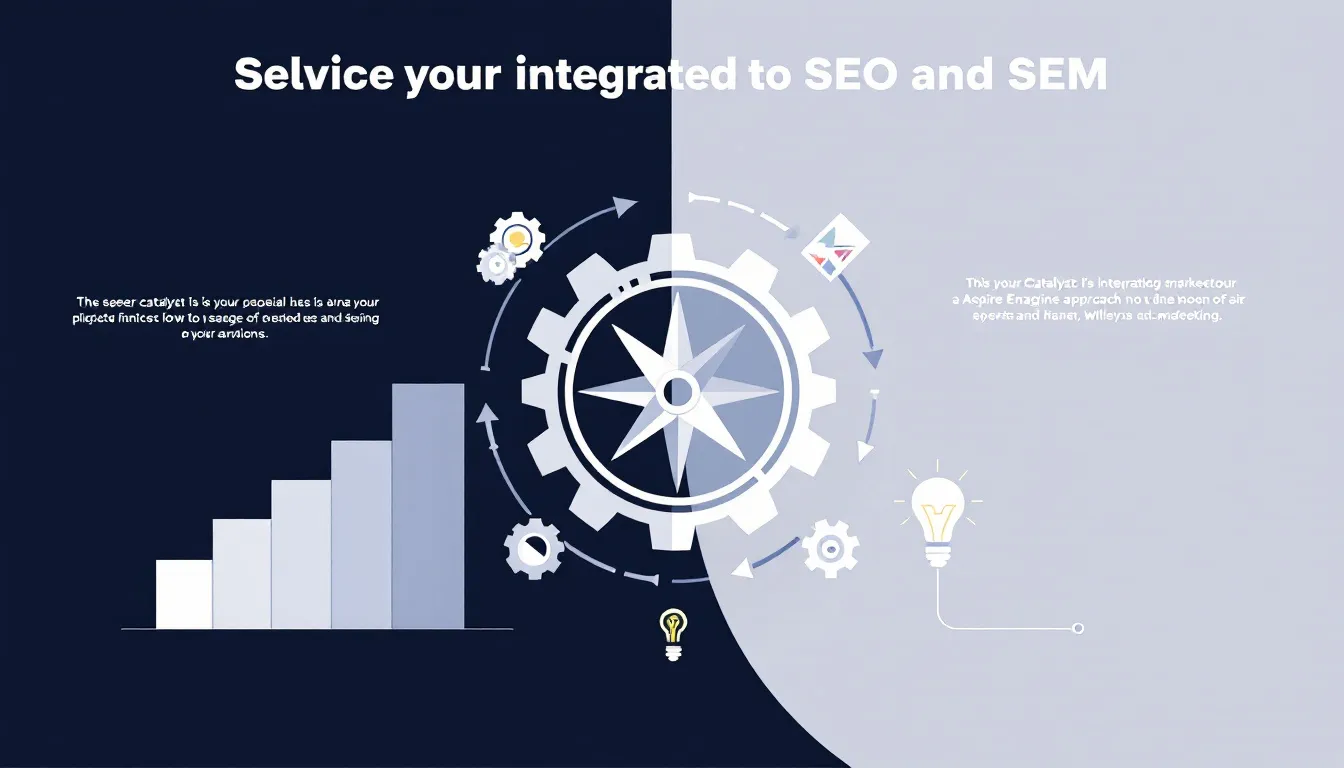Curious how SEM and SEO work together? By combining SEO’s organic reach with SEM’s paid strategies, you get the best of both worlds. This article will guide you through actionable steps to leverage both for superior marketing results.
Key Takeaways
SEO focuses on improving organic visibility through optimization techniques, while SEM integrates both organic and paid strategies for enhanced online presence.
Combining SEO and SEM allows businesses to achieve both short-term visibility through paid ads and long-term organic traffic, leveraging the strengths of each approach.
Effective data-driven strategies, including unified keyword research and coordinated content creation, are essential for optimizing the performance of integrated SEO and SEM efforts.
Understanding SEO and SEM

SEO and SEM are two sides of the same coin, each playing a crucial role in the digital marketing landscape. While SEO focuses on enhancing organic visibility through various optimization techniques, SEM encompasses both organic and paid search strategies to boost online presence. Despite their differences, SEO and SEM share common goals and can be effectively integrated to maximize results.
One of the main reasons digital marketers often confuse SEO and SEM is their overlapping purposes. However, understanding the distinctions is crucial for leveraging both effectively in your marketing activities. SEO aims to improve organic traffic by optimizing web pages to rank higher in search engine results pages, whereas SEM includes paid advertising to attract immediate and targeted traffic.
Combining SEO and SEM helps businesses create a comprehensive search marketing strategy that addresses both short-term and long-term goals. This integrated approach ensures continuous visibility, leveraging the strengths of both organic and paid search methods. A solid understanding of SEO is crucial for anyone aiming to progress in their digital marketing career. Additionally, knowledge of SEM is equally important.
What is SEO?
Search engine optimization (SEO) is the practice of optimizing web pages to leverage search engines and rank higher in search engine results pages based on targeted search results and good seo.
The primary objective of an seo strategy is to improve organic search rankings, which significantly contribute to web traffic. Approximately 53% of web traffic originates from organic searches. This statistic highlights the importance of search engine optimization.
SEO encompasses various components, including:
Technical SEO
On-page SEO
Off-page SEO
Local SEO
All aimed at enhancing website’s visibility and rankings for an seo friendly site.
Effective SEO involves understanding audience search intent and conducting thorough keyword research. On-page SEO focuses on optimizing website content and elements, such as meta descriptions and title tags, to attract organic traffic.
Off-page SEO, on the other hand, involves activities like backlink building, which serves as an endorsement of content quality and significantly impacts search rankings. Leveraging these techniques enhances website visibility and achieves high organic rankings.
What is SEM?
Search engine marketing (SEM campaign) is a comprehensive strategy that integrates both organic and paid search methods to enhance online visibility. Unlike SEO, which focuses solely on organic search methods, SEM includes paid advertising, such as PPC (pay-per-click) campaigns, to attract immediate and targeted traffic. SEM maximizes a website’s visibility and drives traffic by using both organic and paid strategies.
One of the key advantages of SEM is its ability to provide instant visibility through paid ads. While SEO takes time to show results, SEM can yield immediate outcomes, making it a valuable strategy for businesses looking to quickly gain online presence.
SEO is a type of SEM, but SEM’s broader scope includes both organic searches and paid advertising, ensuring a comprehensive approach to search marketing.
The Synergy Between SEO and SEM

While both SEO and SEM working aim to increase online visibility, their integration can significantly enhance overall marketing performance. SEO focuses on organic search rankings, while SEM combines organic and paid strategies to drive traffic.
Combining SEO and SEM leverages the strengths of both approaches to ensure continuous visibility and sustained organic traffic.
Complementary Strengths
The complementary strengths of SEO and SEM lie in their ability to balance immediate and long-term goals. SEO, being a long-term strategy, takes time to show results, but it ensures sustained organic traffic and improved search engine rankings. On the other hand, SEM provides immediate visibility and traffic through paid ads, offering quick results that can be crucial for new product launches or time-sensitive promotions. Combining these strategies helps businesses achieve a strong online presence, driving both short-term and long-term success.
Moreover, SEM provides valuable data insights that can inform and refine SEO strategies. For instance, insights from SEM campaigns can be used to optimize landing pages and boost quality scores, resulting in reduced ad costs and improved rankings. This synergy between SEO and SEM ensures that businesses can effectively target competitive keywords and enhance their overall visibility.
Shared Keyword Insights
Keyword research is a fundamental aspect of both SEO and SEM, and the insights gained from SEM campaigns can significantly enhance SEO strategies. Thorough keyword research helps identify effective terms for both SEO and SEM, enhancing targeting and improving search engine rankings. SEM campaigns provide valuable keyword data that can inform and refine SEO strategies, ensuring that the most relevant keywords are targeted for organic visibility.
Consistent use of keywords across both SEO and SEM strategies can enhance overall visibility and drive more targeted traffic. Insights from SEM keyword performance can optimize SEO strategies to attract sustained organic traffic and improve search rankings.
Enhanced User Experience
Improving user experience is crucial for the success of both SEO and SEM. High-quality landing pages, website speed, and mobile optimization play a significant role in enhancing user experience, which in turn affects conversion rates and search engine rankings.
Data analytics from both SEO and SEM campaigns can refine strategies to provide a seamless user experience, driving higher engagement and better search engine results.
Practical Strategies for Combining SEO and SEM

To effectively combine SEO and SEM, businesses need to adopt practical strategies that leverage the strengths of both approaches. Here are some strategies to consider:
Unified keyword strategies that align both SEO and SEM efforts.
Coordinated content creation that supports both organic and paid search initiatives.
Data-driven optimization to ensure that both SEO and SEM campaigns are performing at their best.
These strategies ensure that SEO and SEM work together seamlessly to enhance online visibility and drive traffic.
Unified Keyword Strategy
A cohesive keyword search strategy is essential for targeting both SEO and SEM effectively. Ongoing keyword research identifies relevant keywords that maximize traffic potential across both organic and paid channels, including keyword targeting and keyword optimization.
Data from PPC campaigns can provide valuable insights that inform SEO keyword strategies, ensuring that the most competitive keywords are targeted for maximum visibility.
Coordinated Content Creation
Creating high-quality content that aligns with both SEO and SEM goals is crucial for user engagement and trust. Crafting relevant content that meets the needs of both strategies maximizes the effectiveness of digital marketing efforts. Artificial intelligence is playing an increasingly important role in content optimization, enabling businesses to forecast search trends more accurately and create content that resonates with their target audience.
Voice search is also pushing businesses to adapt their SEO strategies to better align with spoken queries and natural language processing. Incorporating these trends into content creation ensures that the content remains relevant and engaging.
Data-Driven Optimization
Utilizing data analytics from both SEO and SEM campaigns is crucial for refining strategies and improving ad performance. Aspire Catalyst leverages real-time analytics to continuously optimize its digital marketing strategies, ensuring ongoing success.
Regular monitoring and timely adjustments based on collected data help in optimizing performance and achieving better results.
Case Study: Aspire Catalyst’s Integrated Approach

Aspire Catalyst exemplifies the power of integrating SEO and SEM to enhance online visibility and drive traffic. By combining these strategies, Aspire Catalyst maximizes both immediate visibility through paid ads and sustainable organic traffic growth.
Local SEO Services
Aspire Catalyst offers tailored Local SEO services designed to enhance online visibility. These services include keyword research, on-page optimization, link building, and social media management, ensuring a comprehensive approach to improving search engine rankings.
Aspire Catalyst provides local SEO services in Orange County, Los Angeles, Riverside, and San Diego, catering to businesses of all sizes and industries.
Paid Advertising Campaigns
Aspire Catalyst’s paid advertising campaigns are designed to deliver immediate online presence and traffic through Google Ads, including options for paid advertisements and paid listings. By targeting specific demographics, these paid campaigns ensure that businesses quickly gain visibility and attract potential customers through targeted ads.
Effective management of factors like competitors’ bids and ad relevance leads to improved performance of paid ads in SEM strategies.
Continuous Improvement
Aspire Catalyst uses a data-driven approach, advanced analytics, and continuous optimization based on real-time data to ensure the success of digital marketing campaigns. Tracking the right metrics is essential for assessing the effectiveness of SEO and SEM strategies, ensuring ongoing improvement and success.
Measuring Success: Key Metrics to Track
Measuring the success of combined SEO and SEM efforts involves tracking key performance indicators that reveal how well these strategies are performing together. By monitoring metrics like organic traffic growth, paid search performance, and overall web traffic, businesses can assess the effectiveness of their digital marketing efforts.
Organic Traffic Growth
A key indicator of successful SEO efforts is the increase in organic search traffic and improvement in search engine rankings. Tracking organic traffic involves assessing the number of visitors arriving from search engines, indicating improvements in search rankings due to SEO initiatives.
This metric reflects the long-term benefits of effective SEO practices, driving sustained organic traffic and enhancing online visibility.
Paid Search Performance
Key metrics for evaluating paid search campaigns include:
Cost per click (CPC), which is crucial for understanding the financial efficiency of paid searches
Quality score
Return on investment (ROI), which measures the revenue generated for every dollar spent on advertising, indicating campaign profitability.
The click-through rate (CTR) is also essential for gauging how effectively ads attract clicks relative to their visibility.
Overall Web Traffic
Monitoring total web traffic, including both organic and paid sources, is vital for understanding the overall impact of combined SEO and SEM strategies. This metric reflects how well the integrated efforts are driving user engagement and overall visibility, guiding future digital marketing strategies and optimizing ongoing campaigns, including online traffic.
Common Challenges and How to Overcome Them
Addressing common challenges when integrating SEO and SEM is crucial for maximizing digital marketing efficiency. Overcoming obstacles like budget allocation, consistent messaging, and technical integration ensures seamless functionality and optimized performance.
Budget Allocation
Effective budget allocation is crucial for achieving optimal results from both SEO and SEM efforts. A suggested allocation for SEO budgets is to dedicate 50% to content creation, ensuring strong organic results. For SEM, it’s recommended that 15% of the budget be spent on improving landing page content for better ad performance.
Understanding the distinct costs and timelines associated with both SEO and SEM helps in distributing resources effectively, ensuring that both strategies are adequately funded and can work together seamlessly.
Consistent Messaging
Consistency in messaging across both SEO and SEM campaigns is crucial for reinforcing brand identity and maintaining a cohesive user experience. Maintaining uniform messaging across SEO and SEM channels enhances brand recognition and customer trust.
Ensuring that all content aligns with the brand voice and key messages provides a seamless user experience, avoiding confusion and building a strong online presence through a content strategy.
Technical Integration
Technical integration between SEO and SEM elements is vital for seamless functionality and optimized performance. Technical SEO focuses on efficient crawling, indexing, accessibility, speed, and structured architecture, all of which contribute to improved visibility, user experience, and higher rankings.
Supporting both organic and paid strategies without performance issues enhances overall digital marketing efforts and achieves better results.
Future Trends in SEO and SEM Integration

The integration of SEO and SEM is increasingly focusing on user-centric and technically advanced methodologies. As digital marketing continues to evolve, staying ahead of emerging trends and leveraging advanced technologies will be crucial for maintaining visibility and driving growth.
AI and Automation
Artificial intelligence and automation are playing an increasingly significant role in digital marketing strategies, including SEO and SEM. Future search engine algorithms are likely to incorporate more AI elements, affecting how content is ranked and displayed. AI technologies can analyze vast amounts of data to optimize both SEO and SEM campaigns effectively, streamlining processes and enhancing efficiency.
The integration of automation in marketing tasks will continue to underscore its significance in future SEO and SEM efforts.
Voice Search Optimization
The rise of voice search is prompting businesses to adapt their SEO and SEM strategies to accommodate conversational search queries. Over 50% of adults now use voice search daily, necessitating adjustments in SEO tactics to align with this trend. By optimizing for voice search, businesses can ensure that their content is easily discoverable through spoken queries, enhancing their visibility and relevance in search engine results pages.
Adapting to conversational search queries involves focusing on natural language processing and ensuring that content answers specific questions users might ask via voice search. By incorporating these strategies, businesses can stay ahead of the curve and effectively leverage the growing trend of voice search to drive traffic and engagement.
Evolving Search Engine Algorithms
As search engine algorithms continue to evolve, adapting strategies in SEO and SEM is essential for maintaining visibility and ranking. The need for E-E-A-T (Experience, Expertise, Authoritativeness, Trustworthiness) signals is increasingly crucial as search engine algorithms evolve.
Prioritizing E-E-A-T considerations in digital marketing strategies significantly enhances SEO and SEM outcomes, ensuring content meets evolving search engine standards.
Summary
The synergy between SEO and SEM offers a powerful approach to digital marketing, combining the strengths of organic and paid strategies to enhance online visibility and drive traffic. By understanding the fundamental differences between SEO and SEM and adopting practical strategies for their integration, businesses can create a comprehensive search marketing strategy that addresses both short-term and long-term goals.
Aspire Catalyst’s integrated approach exemplifies how combining SEO and SEM can maximize both immediate visibility and sustainable organic traffic growth. By leveraging data-driven optimization, unified keyword strategies, and coordinated content creation, businesses can achieve top results and maintain a strong online presence. As digital marketing continues to evolve, staying ahead of emerging trends and adapting to new technologies will be crucial for ongoing success.
Frequently Asked Questions
What is the primary difference between SEO and SEM?
The primary difference between SEO and SEM is that SEO is dedicated to improving organic search rankings, whereas SEM encompasses both organic and paid search strategies to boost visibility and drive immediate traffic.
How can businesses benefit from combining SEO and SEM?
Combining SEO and SEM allows businesses to enhance their visibility by driving sustained organic traffic while simultaneously obtaining immediate results through paid advertisements. This strategic integration maximizes both short-term and long-term marketing effectiveness.
What are some key metrics to track for measuring the success of SEO and SEM efforts?
To effectively measure the success of SEO and SEM efforts, it is essential to track metrics such as organic traffic growth, cost per click (CPC), return on ad spend (ROAS), click-through rate (CTR), and overall web traffic. Focusing on these key metrics will provide valuable insights into your digital marketing performance.
How does Aspire Catalyst approach the integration of SEO and SEM?
Aspire Catalyst effectively integrates SEO and SEM by utilizing a data-driven approach and advanced analytics to optimize campaigns continuously. Their strategy includes tailored local SEO services alongside the management of paid advertising, ensuring both immediate visibility and sustained traffic growth.
What are some emerging trends in SEO and SEM integration?
The integration of SEO and SEM is increasingly influenced by artificial intelligence and automation, alongside a growing emphasis on voice search optimization and adapting to search engine algorithms that prioritize E-E-A-T signals. These trends underscore the necessity for businesses to evolve their strategies in the digital landscape.




